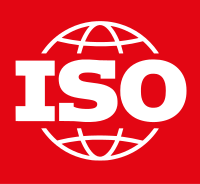International organization for standardization
| International Organization for Standardization ISO |
|
|---|---|
 Organization logo |
|
| English name | International Organization for Standardization |
| Seat of the organs |
Geneva , Switzerland |
| Official and working languages | |
| founding |
February 23, 1947 |
| iso.org | |

legend:
The International Organization for Standardization - ISO for short (from Greek ἴσος isos , German ` ` equal '' ) - is the international association of standardization organizations and develops international standards in all areas with the exception of electrics and electronics , for which the International Electrotechnical Commission (IEC) is responsible, and with the exception of telecommunications , for which the International Telecommunication Union (ITU) is responsible. Together these three organizations form the WSC (World Standards Cooperation).
The ISO is an association under Swiss law (Art. 60 ZGB ).
Origin of the abbreviation ISO
Translations of the name Internationale Organization für Normung result in different abbreviations, depending on the language, for example: IOS (International Organization for Standardization) in English or OIN (Organization internationale de normalization) in French. This is why the uniform abbreviation ISO was chosen, which comes from the Greek word isos , which means 'equal'. This means that the abbreviation is the same in every country and language.
history
From October 14 to 26, 1946, an international conference of national standardization organizations took place in London, attended by delegates from 25 countries. On this, the decision was taken to establish a new international organization that both the ISA - founded in 1926 organization had in 1942 ceased activity - as the well Standards Coordinating Committee of the United Nations - (UNSCC United Nations Standards Coordinating Committee to replace). This organization was to be based in Geneva , where the ISO began its work on February 23, 1947. The then Austrian Standards Institute , since 2009 Austrian Standards International (ASI), and the Swiss Standards Association were founding members.
composition
In the meantime (August 2020) 165 countries are represented in the ISO. Of these, 121 are member bodies (full members), 39 correspondent members (corresponding members) and 4 subscriber members (have observation status). Each member represents one country, with only one member from each country. The German Institute for Standardization e. V. (DIN) has been a member of ISO for the Federal Republic of Germany since 1951 .
There are technical (e.g. MP3 or phone cards ), classification (e.g. country codes such as "DE", "NL", "JP") and procedural standards (e.g. quality management according to ISO 9000 ).
The official languages of the ISO are English , French and Russian . While all ISO standards are published in English and most are also published in French, there are few standards in Russian as Russia is failing to meet its agreed obligations. The national standardization organizations are responsible for translations and national adoption of the standards.
process
The ISO standardization process takes place in several steps.
| step | Surname | acronym | ||
|---|---|---|---|---|
| 00 | Preliminary stage | Preliminary project | Preliminary work item | PWI |
| 10 | suggestion | Application for standards | New Work Item Proposal | NWIP |
| 20th | preparation | Working paper | Working draft | WD |
| 30th | Committee phase | Committee draft | Committee Draft | CD |
| 40 | exam | draft | Draft International Standard | DIS |
| 50 | approval | Final draft | Final Draft International Standard | FDIS |
| 60 | publication | International standard | International standard | IS |
| 90 | Verification | Review | ||
| 95 | retreat | Withdrawal | ||
In addition to the IS, there are four other types of published results from the ISO, the production process of which is different.
| Surname | acronym | Lifetime | |
|---|---|---|---|
| Technical specification | Technical Specification | TS | is to become IS as soon as development is sufficiently advanced |
| Technical report | Technical Report | TR | unlimited |
| Publicly available specification | Publicly Available Specification | PAS | 6 years |
| International agreement | International Workshop Agreement | IWA | 6 years |
Cooperations
Some standards are developed in cooperation with other international standardization organizations, e.g. B. the International Electrotechnical Commission (IEC), developed and published. In the names of these standards, the organizations involved are separated from one another by a slash, e.g. B. "ISO / IEC 8859".
Furthermore, the ISO works together with CEN , which as the European standardization organization transfers a large part of the ISO standards into the European standard system . However, while the transfer of ISO standards into the respective national standardization structure is voluntary, all European standards must be implemented by the CEN members as national standards.
See also
literature
- Friendship Among Equals. Recollections from Iso's first fifty years. International Organization for Standardization, Geneva 1997, ISBN 92-67-10260-5 (review of 50 years of ISO; PDF excerpts from individual chapters: English ( memento of April 2, 2007 in the Internet Archive ), French ( memento of March 24, 2007 2004 in the Internet Archive )).
- Reto U. Schneider : What holds the world together . In: NZZ Folio . February 2005; detailed report on the ISO
Web links
- Official website (English, French, Russian)
Individual evidence
- ↑ iso.org
- ↑ See Art. 18.2 of the ISO Statutes , accessed on March 22, 2017.
- ↑ iso.org/ISO members . The ISO membership (English).